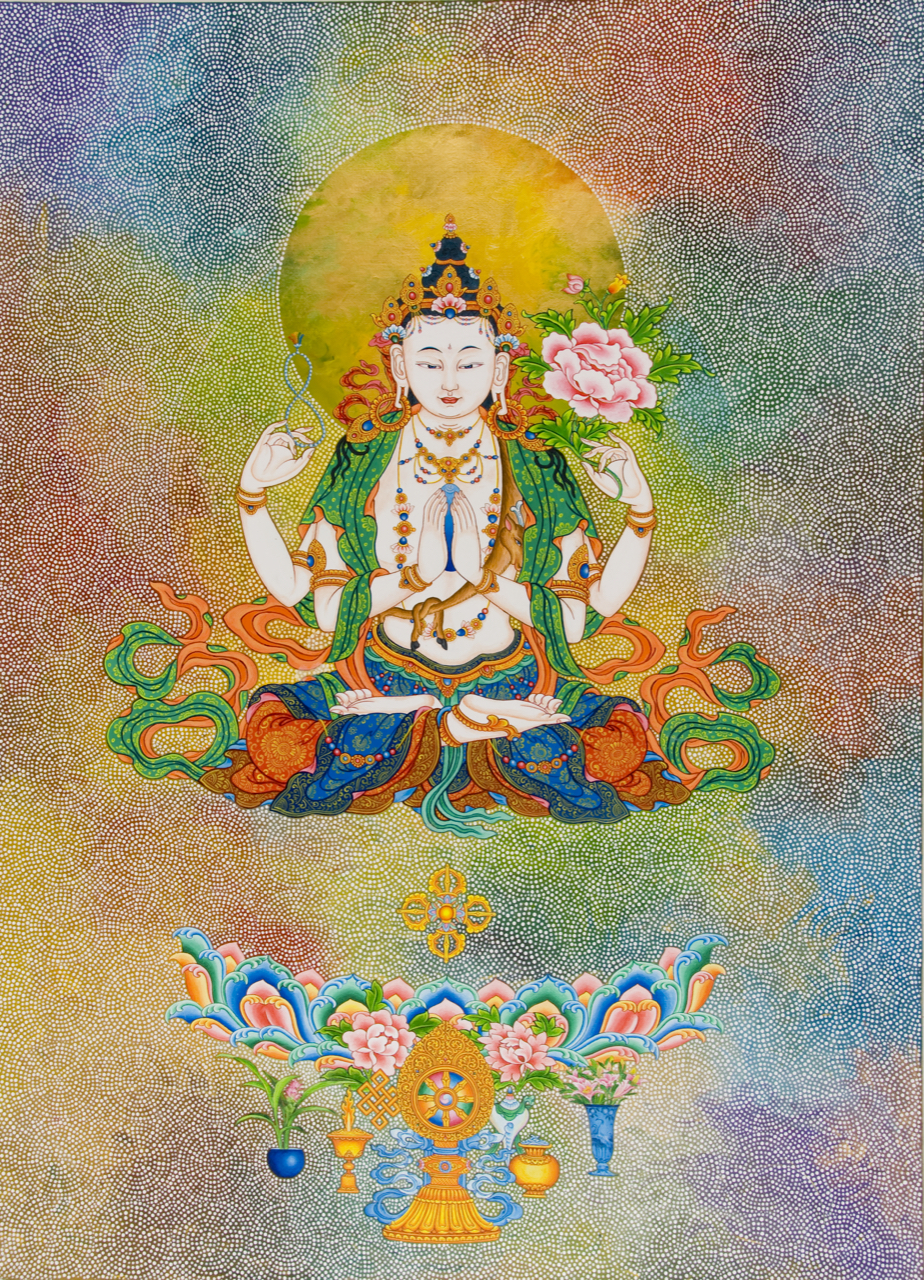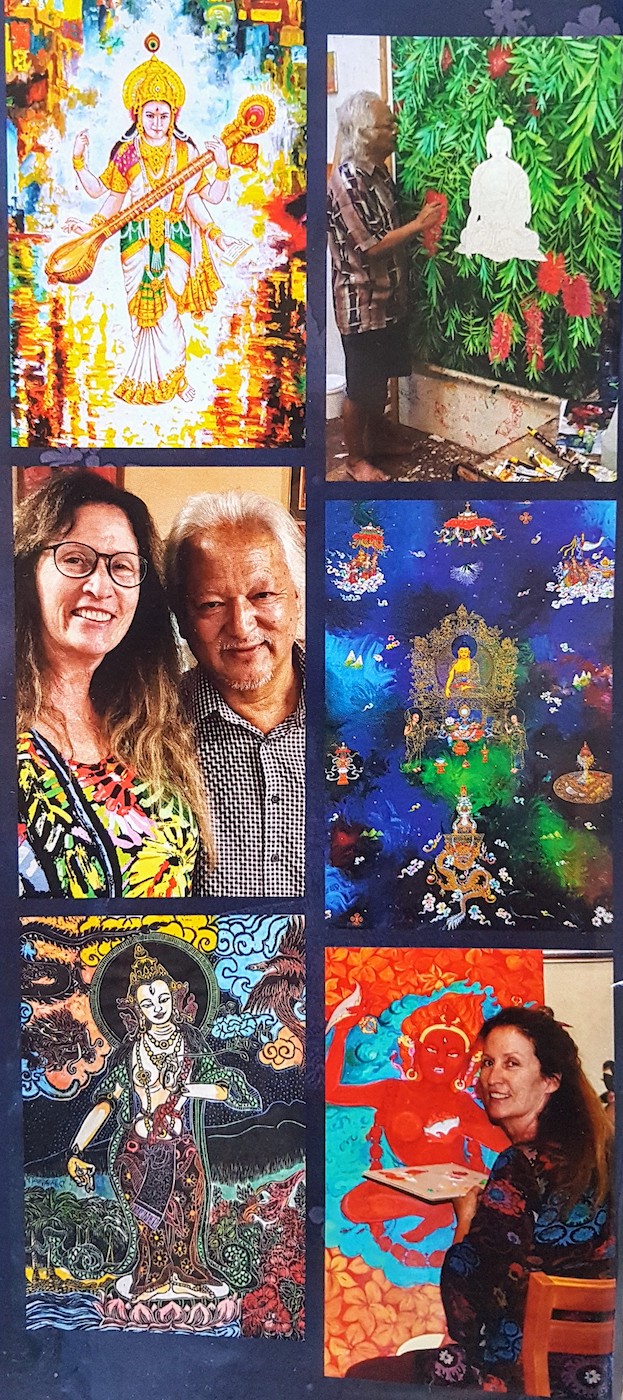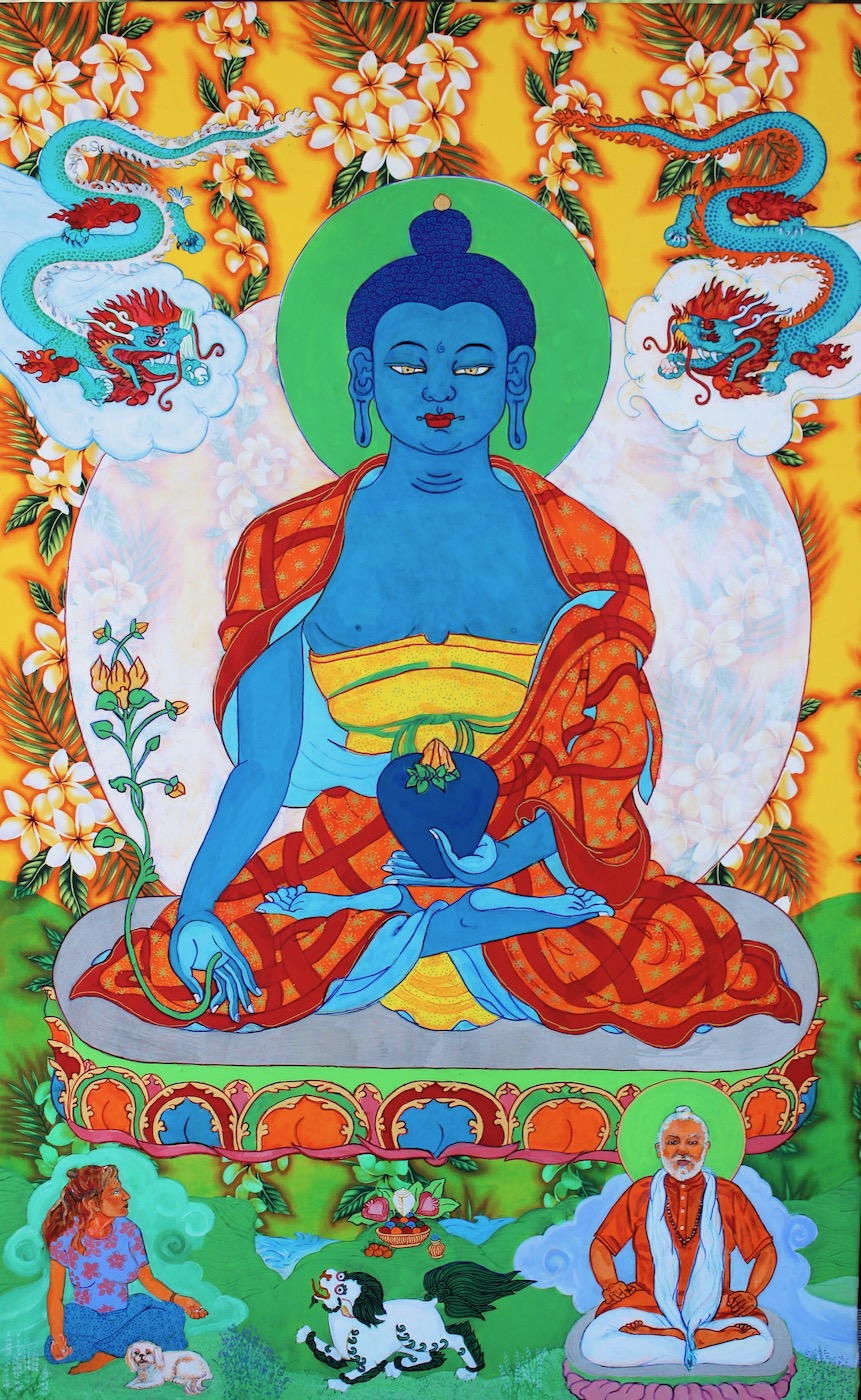FEATURES|COLUMNS|Silk Alchemy
Art and Evolution: The Feminine and the Sacred

Compassion by Karma Phuntsok. Image courtesy of the author
Last month, a fellow artist let me know that she and a friend were about to open a joint art exhibition. The delightful Faith Stone and I met through cyberspace and the collective to which we both belong through our mutual love of Buddhist art. The subject, approach, and roots of these two artists set my muse train in motion. This is not a deep educational essay, nor reportage. Simply my musings over coffee and cake.
In recent decades, a phenomenon has occurred that until fairly recently would have been unthought of and actually societally unacceptable. At least, so the writers of history would have us believe. Yes, yes, we know we are still reeling after centuries of an ego-driven urinating competition that has kept women subjugated. That’s the dinosaur that we’re still trying to evolve past in most parts of the world. But it placed art very much in the hands of religious men. Again, that’s what we've been told. For a vast period of time, in most cultures, art was not a form of personal expression, it was religious propaganda. Far from being a bad thing though, it was a means by which these teachings could be made beautiful and shared within the community.
The Celtic book of Kells as an example, is an incredible body of astonishingly beautiful devotional art. Meanwhile, thangkas are every bit as astonishing in complexity, divinity, and energy. They share in common strict protocols. Preparation of substrates, mineral paints, and execution of iconic forms. From complex knotwork to the Tibetan book of proportions. Everything mapped out in accurate detail.
It can be argued that rules were considered to be very important. And in turn, as icons made their way into the artworks, it was a way that images could be replicated by any artist, and the viewer of the finished piece would, if nothing else, recognize the buddhas, bodhisattvas, gods, deities, and saints in question. It is interesting to note, however, that the gender of the deity was on occasion very fluid, as in the case of Avalokiteshvara as he traveled from India through to Japan. At the birth of his journey, he was presented as the Indian male bodhisattva Padmapani and seemed to have slowly transformed into the very gentle young Japanese Kannon via the increasingly androgynous Avalokiteshvara manifestation to the motheresque Guan Yin, as the emanation of compassion and mercy traversed into the feminine across the landscape. What remained constant however, was the focus of intention, gestures, and accoutrement.
The recent phenomena I alluded to earlier, of course, are women. However, scholars of art history increasingly agree that women were far more active in the painting of religious art than previously thought, or was convenient to the paradigm that recorded and invested in a particular version of history. Sadly, until the Renaissance era, female artists were unrecognized, unmerited, and left anonymous. Most would have been nuns, or related, perhaps by marriage, to a male artist.

Tibetan artist Karma Phuntsok and American artist Faith Stone.
Image courtesy of the author
So, briefly and with thoughts of women as artists in religious and esoteric art as the loose subject of this muse, I am reminded of the growing collection of women around the world and especially in the West who are drawn not only to sacred art but to art that, culturally, has little to do with them. And it’s not just Western privileged, bored housewives either. It’s something that is speaking to the soul or a deep memory of many women who recognize sacred art as something they must express. But often, the old rules aren’t applied in the same way. Call it instinct or channelling, the result is the same, subjective expressions of divinity and spirituality in preference to the strict rules of the old protocols. The risk to this is the loss of dying traditions, of course. We’ve already lost too much of our history. Extraordinary artworks obliterated, even in very recent history. Our ancients really didn’t seem daft, and we benefit from their teachings.
Fortunately, there are those for whom the charge of living history in the present, for the benefit of the future, is a passion. And many painting traditional religious or illuminated art have stepped from the East into the West, with brushes in hand. Ancient traditional Eastern art brought right up to date and into a modern world. Is it a notable point that most Eastern artists are still male, however, suggesting the last legs of a patriarchal paradigm of who has been allowed to paint occult art? Last legs, maybe, but still sadly notable, as is the cooler receptivity of a white woman’s name heading a collection of traditional Eastern sacred art. Sure, I can hear the argument that the culture singing through our DNA should echo in the expression of our creations, however, I know this is changing as the world unites in its orchestral harmonies creating new songs with every generation.
And even if walls are physically going up around the world, we are increasingly breaking borders, intellectually and emotionally. As we know, art is a powerful tool for educating. I have researched and written about the infiltrating nature of imagery on the brain and emotional body, but does art, or should art be culturally relevant to the creating artist? Is sacred art from Ethiopia going to mean the same thing to an Icelander who has never left Iceland? Yet, even without prior awareness of a culture’s sacred art, upon first viewing it can pierce our heart the moment we lay eyes on it and are forever changed.
From my own place, I've been fortunate to be part of a collection of women following a creative spiritual path that endeavors to bridge arcane wisdom teachings into this new world. My expression of the divine is uniquely mine. It can’t be anything else. We each had our own meeting with the sacred that called us and we follow the path. Mine started long before I discovered the joys of caffeine, with Buddhists living in our home. Each artist endeavoring to express subjectively and maybe even to benefit others.
One up-to-date example of this traditional and contemporary marriage of using art to socially educate and spiritually enlighten comes from the two aforementioned artists whose two worlds have fused art and friendship, culminating in what is planned to become an annual exhibition. “Karma & Faith” is Tibetan artist Karma Phuntsok and American artist Faith Stone. Karma, who lives in Australia where he incorporates the indigenous imagery of the country into his Buddhist work, and Faith, who has incorporated her Hawai’ian environment into traditional Buddhist paintings. She paints modern women as deities and is also one of very few who are reviving the ancient techniques of woodblock carvings.*

Aloha Medicine Buddha by Faith Stone.
Image courtesy of the author
You see, it made me think about what it means to be a woman today, in this field of niche art. What it means to be painting things that have been considered the domain of men for so many years. More significantly, what it means to be painting subjects that are culturally not considered our own, and how much we need to hold on to the past yet step into the future. But I am a firm believer in the alchemy arising from the wisdom of ancient history and our modern knowledge. I am a firm believer in each bringing their gift to the table and being judged on merit rather than gender or race. I’m a firm believer in teamwork. I’m a firm believer that women don’t need a male spearhead to empower other women, but I am also a believer in helping each other where we can. We always can.
Hopefully and, so to speak, with open ears, we can hear the new sounds and songs of the present that are vibrating through our souls, creating waves that will resonate far into our collective future. Like music, we use the foundational notes to create wonderful new harmonies. Together. Boys and girls, hand in hand.
* This year’s exhibition runs for a month from 23 August in Colorado. If you feel inclined to see this beautiful show, see the links below.
See more
Karma & Faith (faithstoneart)
Karma & Faith (Dakini as Art)
Art Show: Karma and Faith (Facebook)
Women in Religious Art (Oxford Research Encyclopedias)
Related features from Buddhistdoor Global
An Interview with Renuka Gurung, Scholar of Paubhā, Part One
A So-called Artist: An Interview with Helen Mirra
Expressions of Life and Light by Artist Seta Manoukian
Tara: A Powerful Feminine Force in the Buddhist Pantheon














